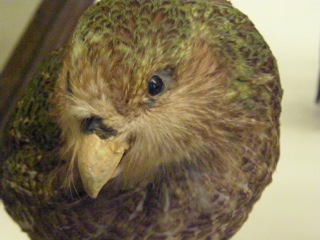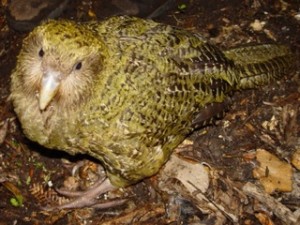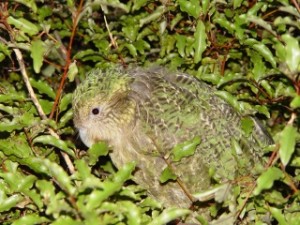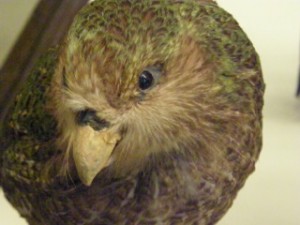In centuries past, if you were to go into the hills of New Zealand on a summer’s night you may have heard a strange noise; a honking boom that resonated all around you. After 20 or 30 cycles of this boom you’d hear a high-pitched rasping ‘ching’ sound. This boom and rasp would come from all around you and would be heard all night, night after night for at least two months. This is the sound of kakapo males trying to attract a mate.
Kakapos, (Strigops habroptilus) are nocturnal, flightless parrots. They are found exclusively in New Zealand and while they were once common across all three main islands of New Zealand, they are now restricted a few small offshore islands. They are unique birds in a number of ways. They are the only flightless parrot and, probably as a result of this, are also the world’s heaviest parrot. They are also the only parrot to chose mates using the lek mating system.
Lek mating involves males displaying for the females and the female picking “the best” male. It’s a winner-take-all scenario as different females usually chose the same male. If you’re the chosen male then it’s a successful breeding season but if you’re not then you go home empty-handed. Males in lek systems typically take no part in the rearing of offspring and kakapo are no different.
Kakapo use an ‘exploded’ lek system, where males are generally out of sight of each other (the more traditional system has all males within eyeshot). During the summer months they go to hilltops and ridges and create a bowl in the earth in which they sit. These bowls are thought to help amplify their booms. They may have several bowls which are linked by tracks created by removing vegetation [1]. They then inflate a sac in their thorax and create the booms and chings. The booms are to attract a female and the ‘chings’ help her to find him as the booms can travel up to 5km while the ‘chings’ are more locatable due to their high frequency. Once a female has been attracted to a particular male and enters his view he performs a dance for her after which they mate
The female lays between one and four eggs in a makeshift burrow, either in cavities such as in those in trees or under vegetation. The eggs hatch within a month and she then has to look after the chicks for up to six months, though they leave the nest after about three months.
Kakapo only reach maturity after the age of about 5 and females only start breeding around the age of 10 [2]. Females reproduce every few years after a masting event. Masts are where plants, in this case the rimu tree, produce large amounts of fruit simultaneously, overwhelming the local wildlife with food. Even with the increased food not every female is able to get fit enough to exert the energetic costs associated with reproduction and so not all females will breed in a given year [3].
As I explained in a previous blogpost, New Zealand avifauna has been threatened by the introduction of predators. Given their slow reproductive rate and terrestrial lifestyle they are particularly vulnerable to predation and have been pushed to the edge of extinction. By the 1970s less than 20 were known to exist and all were males. It seemed that the kakapo were doomed. But in 1977 a female was found on Stewart Island and from that one female a miracle has occurred and the population currently stands at 130 birds.
This success has been hard won. Part of the problem is that so little is known about the birds that trying to get them to breed successfully has been challenging. Added to that the long life-span (it’s not known how long the birds live but it appears to be decades) and the slow reproductive rate means that conservation efforts are going to take decades if not centuries before it is known whether or not they have been successful.
One stumbling block that was hit was an unintended consequence of trying to increase the number of breeding females. Females only breed when they reach a minimum weight. In order to increase the number of breeding females in a given year they were given additional, or supplementary, food. The unintended consequence was that this resulted in more males than females being reared.
The Trivers-Willard hypothesis predicts that females will produce more males when they are in good condition and more females when they are in poor condition. The idea is based on the costs and benefits of each offspring in terms of her ability to transmit her genes to future generations. In polygynous systems a female will be able to mate with a male regardless of her fitness: the males don’t care whether the females are only just fit enough to reproduce or are at peak condition. But in the same system only the fittest males can beat their rivals and gain access to females. The fitness of a female will affect the fitness of her offspring so if she’s not particularly fit it is in her interests to produce females whose future fitness will not significantly affect their reproductive potential. If she’s at peak fitness, however, it’s in her interests to produce males who are more likely to be the dominant male and be able to beat rivals to females.
You may be able to see the unintended consequences already. The supplementary food pushed all the females into top condition and they all produced males. Experimental supplementary feeding at different levels was used to confirm the hypothesis and found to be true [3]. As a result, the supplementary feeding program was adjusted so that females at fed to a level of fitness where they could successfully reproduce but are not so fit that they produce only males. It has been so successful that from the highly skewed sex ratio at the start of the programme it is now approaching parity with 70 males and 60 females.
The conservation program still has a long way to go before kakapo can be considered to be saved. It may be that disease (highly possible given the low genetic diversity) or a series of unfortunate events reduces the population to a level from which it cannot recover. In some sense the birds are living on borrowed time, but despite the uncertainty of success, the effort is well worth it. These birds are unique in the world and are worthy of our care and conservation. Long may their ‘borrowed time’ continue.
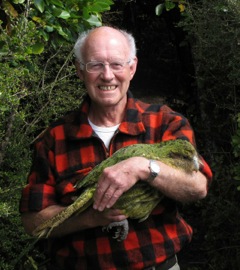
Author: Sarah Hearne, hearnes[at]tcd.ie, @SarahVHearne
Image Sources: Wikicommons
References:

